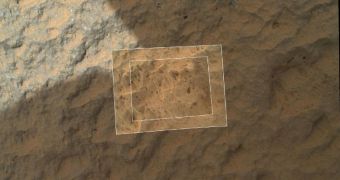About three days ago, the Mars Science Laboratory (MSL) rover Curiosity performed its first contact analysis of a rock on the surface of the Red Planet. The science target, called Jake Matijevic, was probed by instruments on the robotic arm on September 22.
The rock Jake Matijevic is named after MSL's late operations systems chief engineer, who passed away on August 20. It is the first rock on which Curiosity used the tools on its robotic arm. The study will provide important calibration data, meaning that the tools will be ready for complex studies at Glenelg.
That is Curiosity's first major science target. It is an outcrop where three different types of terrain meet, and is located around 400 meters (1,300 feet) from Bradbury Landing, where the rover first touched down on the Martian surface.
Studying Jake Matijevic presented a wonderful opportunity for using the Chemistry and Camera (ChemCam) instrument on Curiosity's mast, and the Alpha Particle X-Ray Spectrometer (APXS) instrument on its robotic arm.
The two are designed to work together, since they produce complementary data sets. By working as a team, they can produce significant volumes of data on the chemical elements that make up rocks.
When Curiosity first drove up to the rock, it used APXS to come in contact with the target. After the instrument finished its studies, the Mars Hand Lens Imager (MAHLI) – also a tool on the 2.1-meter (7-foot) robotic arm – was used to capture close-up images.
Another round of studies using APXS and MAHLI took place the following Martian day (sol 47), on September 23. Additional data collected by the robotic arm-mounted spectrometer allowed more cross-calibration information with ChemCam.
Curiosity will soon resume its trek towards Glenelg, and will most likely reach this target within the next few weeks. Its purpose is to determine whether Gale Crater – the location where it landed – was ever able to support microbial life.
The rover's primary science mission is scheduled to last two years, but its nuclear engine will most likely enable a much longer investigation of the Red Planet.
The mission is managed for the NASA Science Mission Directorate by the agency's Jet Propulsion Laboratory (JPL), in Pasadena, California. The California Institute of Technology (Caltech), also in Pasadena, manages JPL for NASA.

 14 DAY TRIAL //
14 DAY TRIAL //